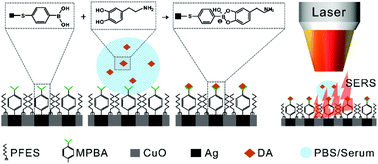Conformational sensitivity of surface selection rules for quantitative Raman identification of small molecules in biofluids†
Abstract
Biofluid analysis by surface-enhanced Raman scattering (SERS) is usually hindered by nonspecific interferences. It is challenging to drive targeted molecules towards sensitive areas with specific capture and quantitative recognition in complex biofluids. Herein, a highly specific and quantitative SERS analyzer for small molecule dopamine (DA) in serum is demonstrated on a portable Raman device by virtue of a transducer of mercaptophenylboronic acid (MPBA) and a site-directed decoration of plasmonic Ag dendrites on a superhydrophobic surface. Theoretical simulations of molecular vibrations and charge distributions demonstrate the predomination of Raman surface selection rules in molecular reorientation upon the binding of DA. This recognition event is translated into ratiometric changes in the spectral profile which evidences excellent capability on SERS quantitation. The rules can well distinguish DA from its common interferents including fructose, glucose, sucrose and ascorbic acid which all generate weak but completely opposite spectral changes. Moreover, benefitting from the wettability difference, the target DA in diluted serum can be specifically enriched on a transducer-capped Ag surface, and the adsorption of other interferences is resisted by superhydrophobic features. It paves a new way for labelling a single SERS tag to simultaneously realize the identification and quantification of small molecules in complex biological media.



 Please wait while we load your content...
Please wait while we load your content...